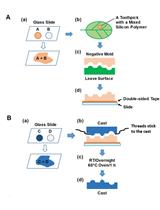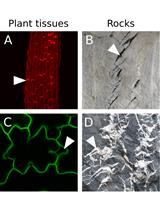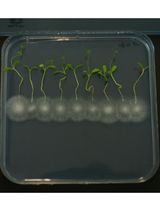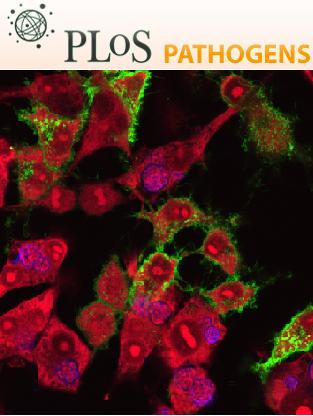- Submit a Protocol
- Receive Our Alerts
- Log in
- /
- Sign up
- My Bio Page
- Edit My Profile
- Change Password
- Log Out
- EN
- EN - English
- CN - 中文
- Protocols
- Articles and Issues
- For Authors
- About
- Become a Reviewer
- EN - English
- CN - 中文
- Home
- Protocols
- Articles and Issues
- For Authors
- About
- Become a Reviewer
DAB Staining and Visualization of Hydrogen Peroxide in Wheat Leaves
Published: Vol 2, Iss 24, Dec 20, 2012 DOI: 10.21769/BioProtoc.309 Views: 22501

Protocol Collections
Comprehensive collections of detailed, peer-reviewed protocols focusing on specific topics
Related protocols

Using Silicon Polymer Impression Technique and Scanning Electron Microscopy to Measure Stomatal Aperture, Morphology, and Density
Hui-Chen Wu [...] Tsung-Luo Jinn
Aug 20, 2017 10156 Views

An Image Analysis Pipeline to Quantify Emerging Cracks in Materials or Adhesion Defects in Living Tissues
Stéphane Verger [...] Olivier Hamant
Oct 5, 2018 6521 Views

Closed Systems to Study Plant–Filamentous Fungi Associations: Emphasis on Microscopic Analyses
Vasiliki Skiada and Kalliope K. Papadopoulou
Feb 20, 2025 2512 Views
Abstract
The production of hydrogen peroxide (H2O2) has been recognized as an important feature of plant cells that undergo programmed cell death (PCD) during host-pathogen interaction. Thordal-Christensen et al. (1997) first described a method using chemical 3,3-diaminobenzidine (DAB) to detect the presence and distribution of H2O2 in barley leaves challenged by the powdery mildew fungus (Thordal-Christensen et al., 1997). Since then, this method has been adapted to many other plant species for in situ detection of H2O2. Here, we describe a modified protocol to stain and visualize H2O2 production in wheat leaves during infection by the necrotrophic fungus, Stagonospora nodrum or infiltration by the necrotrophic effectors produced by the fungus. The short version of this method has been reported in (Liu et al. 2012).
Materials and Reagents
- 3,3-diaminobenzidine (Sigma-Aldrich, catalog number: D8001 )
- 0.1 N HCl
- 95% ethanol (bulked)
- Glacial acetic acid (EMD Millipore, catalog number: UN2789 )
- L-(+)-Lactic acid (Sigma-Aldrich, catalog number: L1750 )
- Glycerol (Life Technologies, Invitrogen™, catalog number: 15514-011 )
- Aluminum foil
- Round plastic screens with the diameter closed to that of 15 ml tube (handmade, help the wheat leaf segments immerse in the staining solution). These plastic screens were cut from a big piece of plastic mesh that can be purchased from a local hardware store or online store (for example, Industrial Netting)
- Wheat leaves at three leaf stage (~2 weeks old grown under the greenhouse conditions)
Equipment
- Polyethylene 50 ml conical centrifuge tube (BD Biosciences, Falcon®, catalog number: C2745 )
- Polyethylene 15 ml conical centrifuge tube (BD Biosciences, Falcon®, catalog number: C2750 )
- Glass petri dish 100 mm with lid (Sigma-Aldrich, catalog number: CLS3160102 )
- Balance
- pH meter
- Shaker
- Vacuum
- Microscope
- Dessicator
Procedure
- Preparation of fresh DAB staining solution
- Measure ~50 ml distilled water and add 0.1 N HCl (1-2 drops) till pH reaches 3.6.
- Pour 10 ml of the above solution into each 15 ml tube (the number of tubes needed is dependent on the number of treatments).
- Weigh 10 mg 3, 3-diaminobenzidine and add to each tube.
- Close the cap, wrap the whole tube with Aluminum foil, and vigorously shake at 37 °C in an orbital shaker for at least 1 h (leaf samples can be collected during this time period).
- Check the solution to see if most of the DAB is dissolved. The solution should be colorless or slight pink and should be used fresh for staining.
- Measure ~50 ml distilled water and add 0.1 N HCl (1-2 drops) till pH reaches 3.6.
- Staining of wheat leaves
- Collect wheat leaves at the designated time points after inoculation with the pathogen or infiltration with toxins. The fungal inoculation and toxin infiltration in this case were done at three leaf stage.
- Cut infiltrated or inoculated areas of the leaves into 3 cm long segments and immerse them in the DAB solution with a plastic screen (no more than 8 leaf segments in one 15 ml tube).
- Place all tubes with the caps removed in a vacuum dessicator and vacuum for 30 min at room temperature. It’s not necessary to keep the tubes in the dark at this step.
- Release vacuum and place all tubes in a dark cabinet with the caps closed and incubate overnight.
- The necrotic areas caused by the fungus or the toxin should be dark brown in color.
- Collect wheat leaves at the designated time points after inoculation with the pathogen or infiltration with toxins. The fungal inoculation and toxin infiltration in this case were done at three leaf stage.
- Clearing of leaves for examination (all procedures should be carried out in a fume hood)
- Gently rinse DAB solution off the stained leaf segments using distilled water and dry slightly on paper towels.
- Place the leaf segments on paper towels saturated with a fixative solution (ethanol/acetic acid 3:1, V/V) in a petri dish. A little amount of extra solution left in petri dish is allowed.
- Incubate the leaf segments at room temperature in a fume hood for at least 24 h (it may require additional time to clear all the chlorophyll from the leaf tissue).
- Transfer the cleared leaf segments to paper towels saturated with water and leave for 30 min to remove any fixative residues.
- Transfer leaf segments on paper towels saturated with a lactoglycerol solution (lactic acid/glycerol/H2O 1:1:1, v/v/v). A little amount of extra solution left in petri dish is allowed.
- Leaf segments can be subjected to examination after a couple of hour incubation at room temperature or stored on paper towel saturated with the same lactoglycerol solution for several weeks.
- For examination, carefully mount leaf segments on a glass slide and observe under the microscope to determine the cellular location of DAB. Photographs can be made using a white background.
- Gently rinse DAB solution off the stained leaf segments using distilled water and dry slightly on paper towels.
Acknowledgments
This protocol was adapted from a method published in Liu et al. (2012), which was originally based on the descriptions by Thordal-Christensen et al. (1997). Development and implementation of this protocol was funded by USDA-NIFA AFRI Microbial Biology Program - Competitive grant # 2010-65108-20543, and by USDA-ARS CRIS Project #5442-22000-048-0D.
References
- Liu, Z., Z. Zhang, J. D. Faris, R. P. Oliver, R. Syme, M. C. McDonald, B. A. McDonald, P. S. Solomon, S. Lu, W. L. Shelver, S. Xu and T. L. Friesen (2012). The cysteine rich necrotrophic effector SnTox1 produced by Stagonos pora nodorum triggers susceptibility of wheat lines harboring Snn1. PLoS Pathog 8(1): e1002467.
- Thordal-Christensen, H., Z. Zhang, Y. Wei and D. B. Collinge (1997). Subcellular localization of H2O2 in plants. H2O2 accumulation in papillae and hypersensitive response during the barley—powdery mildew interaction. Plant J 11(6): 1187-1194.
Article Information
Copyright
© 2012 The Authors; exclusive licensee Bio-protocol LLC.
How to cite
Readers should cite both the Bio-protocol article and the original research article where this protocol was used:
- Liu, Z. and Friesen, T. (2012). DAB Staining and Visualization of Hydrogen Peroxide in Wheat Leaves. Bio-protocol 2(24): e309. DOI: 10.21769/BioProtoc.309.
- Liu, Z., Z. Zhang, J. D. Faris, R. P. Oliver, R. Syme, M. C. McDonald, B. A. McDonald, P. S. Solomon, S. Lu, W. L. Shelver, S. Xu and T. L. Friesen (2012). The cysteine rich necrotrophic effector SnTox1 produced by Stagonos pora nodorum triggers susceptibility of wheat lines harboring Snn1. PLoS Pathog 8(1): e1002467.
Category
Plant Science > Plant cell biology > Tissue analysis
Cell Biology > Cell staining > Reactive oxygen species
Biochemistry > Other compound > Reactive oxygen species
Do you have any questions about this protocol?
Post your question to gather feedback from the community. We will also invite the authors of this article to respond.
Tips for asking effective questions
+ Description
Write a detailed description. Include all information that will help others answer your question including experimental processes, conditions, and relevant images.
Share
Bluesky
X
Copy link









